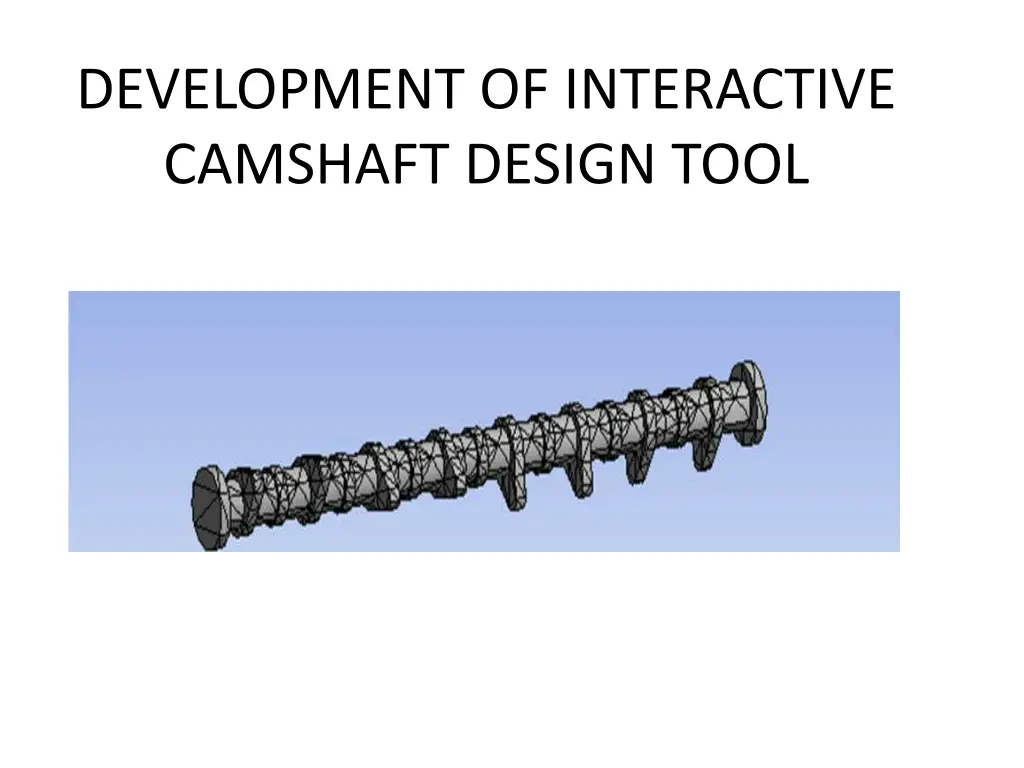
Interactive Camshaft Design Tool Development
Explore the development of an interactive camshaft design tool, crucial for controlling valves in combustion engines to enhance performance and efficiency. Learn about camshaft operation, types, and materials used in production.
Download Presentation

Please find below an Image/Link to download the presentation.
The content on the website is provided AS IS for your information and personal use only. It may not be sold, licensed, or shared on other websites without obtaining consent from the author. If you encounter any issues during the download, it is possible that the publisher has removed the file from their server.
You are allowed to download the files provided on this website for personal or commercial use, subject to the condition that they are used lawfully. All files are the property of their respective owners.
The content on the website is provided AS IS for your information and personal use only. It may not be sold, licensed, or shared on other websites without obtaining consent from the author.
E N D
Presentation Transcript
DEVELOPMENT OF INTERACTIVE CAMSHAFT DESIGN TOOL
ABSTRACT Camshafts are crucial components in combustion engines. Their purpose is to control the opening and closing of intake and exhaust valves, which affects various aspects of an engine s performance. The valves control the intake of the air-fuel mixture in the combustion chamber and the exhaust of combustion gases. The synchronization of this task with the engine s cycle is essential for the system to work as desired, and timing parameters such as valve duration affect the engine s power and efficiency
INTRODUCTION A cam is a mechanical device used to transmit motion to a follower by direct contact. The driver is called the cam and the driven member is called the follower. In a cam follower pair, the cam normally rotates while the follower may translate or oscillate.
CAM AND CAMSHAFT Camshaft Operation: The camshaft uses lobes (called cams) that push against the valves to open them as the camshaft rotates; springs on the valves return them to their closed position. This is a critical job, and can have a great impact on an engine's performance at different speeds.
TYPES OF CAMSHAFTS Single Overhead Cam: A single overhead cam has one cam per head. So if it is an inline 4-cylinder or inline 6-cylinder engine, it will have one cam; if it is a V-6 or V-8, it will have two cams (one for each head). On single and double overhead cam engines, the cams are driven by the crankshaft, via either a belt or chain called the timing belt or timing chain.
Chilled iron castings: This is a good choice for high volume production. A chilled iron camshaft has a resistance against wear .When making chilled iron castings, other elements are added to the iron before casting to make the material more suitable for its appli- cation. Chills can be made of many materials, including iron, copper, bronze, aluminum, graphite,and silicon carbide
CARBON STEEL Carbon steels-EN8, EN99 Used mainly in the 1930 to 1945 period and is currently used for induction hardened camshafts in conjunction with roller cam followers, due to the through-hardening characteristics of the material
ALLOYED STEEL o Alloyed steels: EN351 8620, EN34 Used in british period o Nitriding steels:EN40B The best steel for camshafts. When nitrided it gives a surface hardness and finish similar to chilled Iron. We used this when replacing chilled iron camshafts in competition engines. This material is used on several of the current F1 engines.
TUNGESTEN While using the tungesten materials, the required camshaft have higher tensile strength and bears a temperature of over 1650 C. It has high melting point of 3410 C
METHODS OF MANUFACTURING There are mainly 3 types. Casting Forging Machining
ADVANTAGES Tungsten weights are smaller in size and denser in weight. Tungsten produces more sound under water. It has better feel on under water objects.
DISADVANTAGES The only disadvantage is of high cost.
CONCLUSION When purchasing a camshaft, enquire which material the camshafts are produced from. A chilled iron camshaft may be more expensive, but its resistance to wear in all conditions, far exceeds any other type of cast iron.
